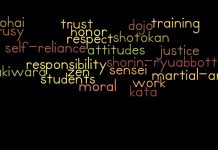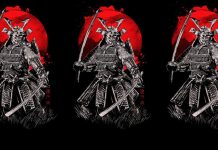In my previous articles, Earning a Black Belt and The Sparring Dilemma, I discussed how mastery of the martial arts involves learning how to apply technique rather than just executing it and how a well designed sparring curriculum is one of the safest and most effective ways to develop this skill. Unfortunately, as the focus of traditional martial arts training has shifted away from combat, there are increasingly fewer instructors who know how to teach this. This is as true in China, considered the birthplace of martial arts, as it is anywhere else in the world.
Recently in China a challenge match took place between a mixed martial arts (MMA) fighter and a self-proclaimed taiji/tai chi master. The match occurred after the MMA fighter publically questioned the effectiveness of taiji in combat. The match took place in front of a large crowd at the taiji school, with the MMA fighter beating the taiji master into submission in less than 10 seconds. Video of the match quickly went viral, leading many, including the MMA fighter, to question the effectiveness of all traditional martial arts.
With all of the controversy surrounding this fight, I think this is an excellent opportunity to discuss the merits of training in traditional martial arts, and taiji in particular. Traditional martial arts developed on the battlefield, so to say that they are inapplicable in modern combat misses the point. Fighting is fighting. Hand to hand combat has not changed in thousands of years. With two arms and two legs, humans have always fought using strikes, sweeps, throws, locks, and chokes. What has changed is the context of hand to hand combat, as well as the focus of martial arts training, both traditional and more modern.
As I mentioned in Earning a Black Belt, the release of the Karate Kid in 1984
led to a huge increase in the number of children studying martial arts in the US. This shift gradually changed the focus of training from combat to character development and attainment of rank. The focus of martial arts training in China began shifting in 1958 when the Communist Party of China introduced the All China Wushu Association. Rather than focusing on combat, the Association emphasized sport and health. The Cultural Revolution of 1966 accelerated this shift as many traditional instructors fled the country, taking their styles with them.
Had it not been for the success of the 2008 Beijing Olympics, the shift in focus of training following the creation of the national Wushu Association and the loss of so many instructors during the Cultural Revolution could have meant the end of traditional martial arts in China. Fortunately, the Olympics as well as the Bruce Lee documentary that followed it have led to something of a martial arts renaissance in China. This is especially true for taiji and wing chun. But that popularity, along with a lack of traditional instructors, have created new issues.
In the absence of traditional instructors teaching the combat applications of taiji, mastery of the health aspects, or art, of taiji can easily be mistaken for mastery of taiji. But as the taiji fighter in the challenge match discovered, mastery of the art and the ability to apply the art are two very different concepts. This is the same type of discovery that occurred with the introduction of MMA in the US. The lack of success fighters from traditional styles have had in the Ultimate Fighting Championship (UFC) since its inception in 1993 has led to the same debate in the US that China is having now about the effectiveness of traditional martial arts.
While the shift in training away from combat that occurred in both the US and China has obviously affected the success of fighters from traditional styles, it is important to remember that the context of combat has also changed. As previously mentioned, traditional martial arts developed on the battlefield where combat was a matter of life and death. Today, other than street fights, MMA is the closest thing to actual combat, but even it has a variety of rules to ensure fighter safety. So many of the techniques developed on the battlefield are illegal in sport, often leaving traditional martial artists at a competitive disadvantage.
With all of the changes in training and combat that have occurred over the last century, it might be easy to assume that traditional martial arts are simply not effective in modern combat. But if taiji is any example, traditional martial arts still have a great deal to offer students. Not only does taiji have a carefully designed sparring curriculum that allows students to learn how to apply technique in the context of modern combative sports, its emphasis on structure and alignment enhances any style of martial arts, traditional or modern. All this from a martial art typically practiced by seniors in parks!
The emphasis on health in modern taiji training has proven so popular that today many taiji students are unaware of its origins or combat applications. Taiji is one of several internal martial arts, meaning power is generated primarily through hip rotation, as opposed to external martial arts which generate power through the contraction of skeletal muscle. Taiji is usually practiced slowly to emphasize proper structure and alignment. Proper alignment, when combined with meditative style breathing, can increase blood and oxygen flow throughout the body. This leads to many of the health benefits taiji is now so well known for.
Although the art of taiji is usually practiced slowly, combat occurs in the blink of an eye. Going from slow to full speed is a big jump and not one to take lightly. As I mentioned in The Sparring Dilemma, one way to introduce fighting to students is grappling. This allows students to develop a feel for contact without the fear of getting punched in the face. Taiji has two versions of grappling, push hands and shuai jiao. Both push hands and shuai jiao allow students to further develop their understanding of taiji’s principles while at the same time learning to apply technique against an opponent. Like Brazilian Jujitsu (BJJ), push hands and shuai jiao have grown into popular sports of their own.
While push hands and shuai jiao, like any form of grappling, are excellent ways to introduce fighting, they are not by themselves enough to prepare students for combat. Any version of sparring that does not include the risk of getting punched in the face will not adequately prepare students mentally or physically for combat. As Mike Tyson said, “Everyone has a plan until they get punched in the mouth”. Traditional martial arts such as taiji include this type of training as well. When taiji students are ready, they move from push hands or shuai jiao to Chinese kickboxing, which is usually called sanda, sanshou, or lei tai when a platform is used.
Anyone familiar with sanda, sanshou, or lei tai knows how similar they are to other forms of modern combatives such as MMA or Muay Thai. The most well known sanshou fighter in the US is probably Cung Le, who had a successful career in MMA after going undefeated in professional sanshou and kickboxing. Of course, the percentage of taiji students that make the transition from the art to sanshou is rather small, especially when most schools focus on health. But the fact that such a transition is even possible should go a long way towards answering the question of whether taiji and other traditional martial arts are still effective today.
If taiji’s ability to adjust to the changing context of modern combat is not enough to settle any doubts regarding its effectiveness, its ability to actually enhance other styles means taiji will remain relevant as long as hand to hand combat exists. As I mentioned earlier, taiji relies primarily on hip rotation to generate power rather than relying on strength and speed. Not only does this allow taiji students to generate more power than they could relying solely on athletic ability, they are able to do so while using less energy. The ability to generate more power with less effort should interest any martial artist regardless of style or goal.
The ability to generate more power with less effort is just one of taiji’s many contributions to martial arts. But the contributions don’t come from any particular style or technique. They come from the principles upon which taiji is based. These same principles are found in any complete martial arts style or system. Again, fighting is fighting. As long as hand to hand combat exists, the need for these principles will remain, meaning traditional martial arts such as taiji will remain effective and relevant regardless of the goal or context.





